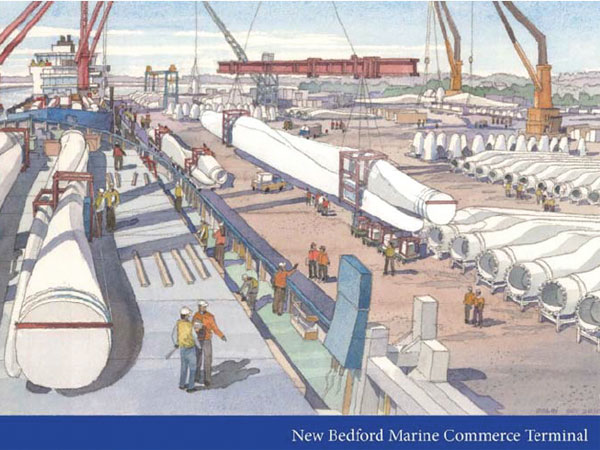Long Time Coming
Offshore Wind eEvolution
A long time coming as New Bedford Marine Commerce Terminal inks lease as the primary staging area for Vineyard Wind offshore wind far project.
It was a long time coming, but Massachusetts’ New Bedford Marine Commerce Terminal is finally getting business…and a lot of respect.
The Vineyard Wind project, America’s first large-scale offshore wind development, will lease the New Bedford terminal for at least 18 months as its primary staging facility, at an annual cost of $6 million. While the exact timetable for the project is still uncertain, the lease will stretch from December 2020 into 2022, and quite possibly beyond.
“At least for the first couple years, it’s going to be pretty much at capacity,” said Richard Baldwin, principal consultant at Ramboll, a consultancy that specializes in offshore wind development.
Vineyard Wind is an 800MW wind farm that will be constructed 14 miles south of Martha’s Vineyard.
The 29-acre heavy lift facility at New Bedford was specifically built to stage the offshore wind industry. It’s the first in the US to do so and is far ahead of others now being planned.
“We feel that we’re well positioned to not only support offshore wind development in these first few years of the US offshore wind industry, but also looking forward to the future,” said Gregory Dolan, the terminal manager.

Long Time Blowing in the Wind
The saga of the terminal is one of persistence, setbacks and, ultimately, some success. Construction began in 2013 on the site of a long-abandoned fabric mill. The vacant site lay south of the New Bedford Port, the largest fishing port in the US.
The project’s centerpiece is a 1,200-foot-long pier, with uniform load-bearing capacities of 20 metric tons per square meter and concentrated loads of up to 100 metric tons per square meter. This is critical as turbines and blades are becoming larger and heavier.

“The terminal is designed for at least the next generation of turbines to come,” said Dolan, who was also involved in the planning and design of the terminal. “Even in comparison to the European ports, it’s definitely at the higher end” when it comes to load bearing.
The terminal ended up costing $113 million. But 60% of that money was spent on environmental cleanup and remediation. The port of New Bedford is a federal superfund site and construction included removal of PCVs and other contaminants from the harbor, as part of channel improvements, as well as removal of contaminants on the site itself.
The terminal is part of the Massachusetts Clean Energy Center, a state economic development agency.
The New Bedford Terminal was aimed to at first support the Cape Wind project, the ultimately doomed almost-two-decades-long effort to construct wind farms in Nantucket Sound, off Cape Cod. Wealthy residents litigated the project to death, while Democratic Senator Edward Kennedy battled against it in Washington. Cape Wind ultimately sank in court in 2017.
Meanwhile, the terminal, completed in early 2015, has stood pretty much empty, although it recently hosted delivery of onshore wind turbines destined for western Massachusetts. It’s also being used by survey vessels for other offshore projects.
According to Bruce Carlisle, senior director for offshore wind at the Clean Energy Center, state officials had been working with the federal Ocean Energy Management about wind projects further offshore since 2009.

Follow us on social media: